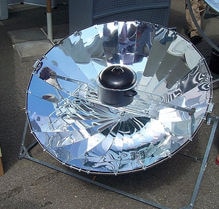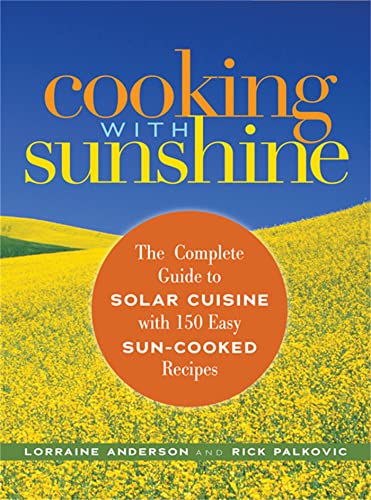
Solar Cookers
Solar Cookers allow Cooking with Sunlight
![]() The sun is really powerful and solar energy is one the most resourceful sources of energy for the future. We all know that in just a few days our sun showers us with enough solar energy to equal all the total energy used by man and best of all it’s renewable and it’s free. Solar energy is the energy force that sustains life on the Earth for all plants, animals, and people, so why not use solar cookers to cook our food and heat our water.
The sun is really powerful and solar energy is one the most resourceful sources of energy for the future. We all know that in just a few days our sun showers us with enough solar energy to equal all the total energy used by man and best of all it’s renewable and it’s free. Solar energy is the energy force that sustains life on the Earth for all plants, animals, and people, so why not use solar cookers to cook our food and heat our water.
We even use it to make electricity, then it only seems logical that one way we can use the sun’s immense energy potential is to cook. Most of us know how it can be hot enough to fry an egg on the pavement or hood of a car. Then we can boil, bake, fry, or even cook a hot dog in our own back yards using only the solar power of the sun with no external heat sources.
The sun is a great source of energy for cooking and one way to do this is with a Solar Cooker, also known as a “solar oven”. A solar cooker captures energy from the sun and turns it into heat. But what’s great about solar cooking is that we do not need any special materials or equipment to collect the sunlight.
One of the main advantages of a solar cooker design is its simplicity and versatility in construction. It can be made from a variety of different materials, and can be easily adapted to any number of cuisine or food types and cooking styles, from baking to roasting.

Most solar cookers are often made using aluminium foil or a mirror so that the sunlight reflects off the foil or mirrored surface into the center of the oven.
Glass or plastic shrink wrap to trap heat & hot air and stop the heat escaping. Black cooking pots or dark cooking utensils are used to cook the food as black easily absorbs heat energy. So if you want something to warm up quickly in sunlight, paint it black!
Solar cooker designs can look deceptively simple when placed next to some of the more traditional forms of cooking equipment. Yet solar ovens can have cooking times comparable to a conventional oven reaching temperatures of over 120oC (250oF), and cooking about 4 or 5kg (about 10 pounds) of food on a sunny day.
The advantage of solar cookers is that they can cook large quantities of food slowly and evenly. Millions of people can’t find enough wood to cook, using solar cookers is a good idea.
How Do Solar Cookers Work
So how do solar cookers work. Whatever their shape, solar cookers work because sunlight carries lots of power. When sunlight hits a surface with an area of 1 square meter, there is about 1,000 watts of solar energy available from the sun on that surface.
Sunlight is concentrated in the cooking area that gets hot enough to cook food by using mirrors or any reflective surface. The more sunlight that is captured or reflected, the more power that can be generated.
While there are many different solar cooker designs to choose from, the most widely used and most fool proof, is the Solar Box Cooker. Solar box cookers are large insulated boxes painted black on the inside (to absorb sunlight) with a transparent cover (usually glass), and one or more reflective panels that allow more sunlight to enter the cooking chamber.
The sun’s heat is captured inside an enclosed area usually a box, hence their name, and is absorbed by the food and pots or pans inside. Solar box cookers sometimes have an insulated cooking chamber to prevent heat from escaping. the food being cooked is placed inside the chamber in a dark-coloured pot.
Just as we cook differently with stove tops, ovens and microwaves, different types of solar cookers are used differently. As the food can be cooked inside a sealed box, solar box cookers act as solar ovens and can be used to cook or bake food and even pizza’s using a low heat over a long time. Since it is almost impossible to burn food in a solar box cooker, it does not matter how long food is left to cook.
Solar Panel Cookers
Solar Panel Cookers on the other hand use a parabolic shaped reflectors or dishes to concentrate the passive solar energy onto a central focal point at the bottom of a pot. Depending on the size of the reflector, very high temperatures can be reached.
The advantage of solar panel cookers is that foods can be cooked just about as fast as on a conventional home stove. The disadvantage is that they are complicated to make and must be continually rotated and focused to follow the sun. As they focus sunlight onto a very small area, they can cause burns and eye injury if not used correctly.
A parabolic shaped solar cooker can be used like a conventional stove top. By concentrating the sunlight onto a very small area it is possible to heat a pan or pot to a very high temperature quickly. Although these parabolic solar cooker designs can generate high power, they typically do not have an insulated cooking chamber so are used mainly for boiling, frying food or by holding the food in the focal point (like a hot dog on a stick).
Solar steamers are another form of parabolic solar cooker. Solar steamers work just like they sound. The cooker’s heat boils water to make steam, which cooks the food just like a pressure cooker, except that the sun provides the power, all for free. Also with a solar steamer, dirty water can be brought to a boil making the water safe to drink once cooled.
Solar cookers and solar ovens are great for cooking food when your camping, at the beach, or for off-grid home living. They are also extremely safe as there are no fires involved in the cooking process, use no flame and can be used in fire restricted areas.
There are many types of solar cookers as they come in may shapes and sizes. The most common types are the box solar cookers which trap heat in some form of insulated box or compartment. A box solar cooker can be fairly portable and very durable. The cooking compartment can be any size you wish, big enough to even roast a turkey.
In most of these solar cooker designs the sun’s energy actually strikes the food so clear sunshine is essential for cooking. You can cook on partly cloudy days but it will take longer. To increase the power and efficiency of a solar cooker further, solar reflectors can be used to concentrate light onto a focal point. Reflectors can be made out of aluminium foil, mirror glass, polished aluminium, stainless steel or any item that reflects light well. Good reflectors are very important so make your reflector surface as large as the area you are reflecting into.
Solar cookers have a number of fantastic advantages. Anything you can cook in a normal oven can be cooked in a solar oven, the limit is your imagination. Just remember to use a dark coloured pots and pans, and use pot holders as solar ovens get very hot. Remember, safety first and use caution with a solar cooker, especially when children are around as the intensified light can cause fires, burns and is harmful to the eyes.
To learn more about “Solar Cooking” and how to use the sun to cook your food, or to follow a step-by-step guide on how to make a solar box cooker using simple stuff you have lying around at home then Click Here to order your copy from Amazon today and find out more about solar cooking, solar cuisine and cooking with the sunshine.











I have 2,3 questions.1-What should be the material of parabolic dish?2-Are Aluminium will be good/enough reflector to cook food in pot??3-How much minimum temperature/sun radiation required to cook quality food??
Great information and nice article, Help us to learn about the solar cooking
a wonderful invention. it will be very useful to protect nature and flowers.
It is a great innovation. It is pollution free & can be used for cooking foods for huge number of people.
this is the most important thing ever you can use this if you are stranded like somewhere else and like you want to cook so you can use that method.
DIS WEBSITE IS OVER WELMING AND COOL AT THE SAME TIME AND WE ARE LEARNING ABOUT THE 3 SOLAR OVENS THIS SITE IS purrrrrFECT
Nice,we are doing research on the 3 solar ovens and this is the perfect website 4 it.
I love solar cooking. My homeroom class is going to build one. Yay 🙂
Definitely would like to try this one day. We install solar panels on roofs and convert them to electricity for home use. Should definitely harness this technology and use it to cook food. Thanks for all the detailed info. This is excellent.
I am grateful for the article. Really Cool and helped me understand.
Have you thought about adding some videos to the article? I think it might enhance viewers understanding.
Solar cooking is the best way to cook food without any difficulty without any fuels. If anyone wants to make food with solar cooking, then they have to buy solar cooker, or we can also make solar cooker at our home. Solar cooking process is also a great educational tool so students are as well involving in the many kinds of solar cooking projects. 🙂
I have a question about using glass jars as cooking vessels in solar cookers. The lids of most commercial jars have gaskets in them, and in the USA, many of these gaskets apparently are made with PVC. Jar lid manufacturers say the PVC is stable at temps up to 225 degrees F. When these lids are painted black and used in a solar cooker, the lids can get heat up to 250 degrees. So is there a health danger in cooking food in a vessel that has a little PVC in it that may be heated above the temperatures it was designed to withstand?
Hello Ramon, try a test jar and see what happens. If the seal melts then don’t use. Can you not put the jar’s contents in another pot on the solar cooker.